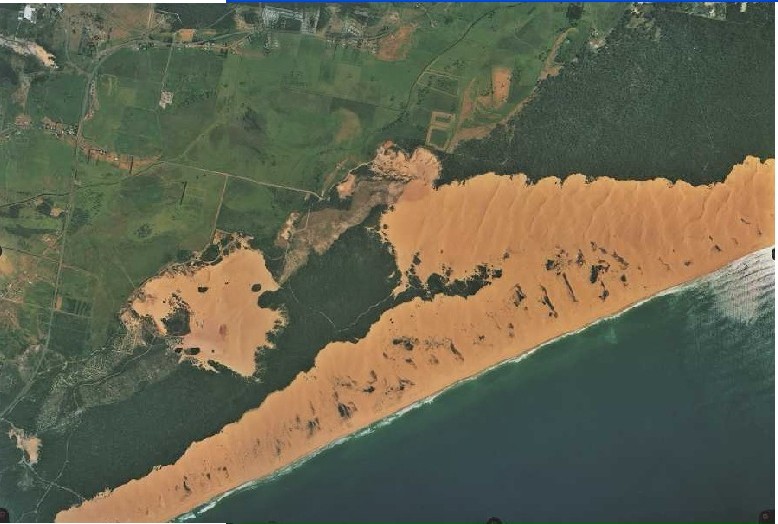
3.0 Nature and Rates of Change
Like all ecosystems, Coastal Sand Dunes do change over time. The causes of these changes have predominantly been natural, but in recent times humans have contributed greatly to the rapid changes that have occurred on Coastal Sand Dunes.
a) Natural Change
The Accretion Cycle and Natural stress
By their very nature, Coastal Sand Dunes are constantly changing because of the biophysical interactions that occur in the accretion cycle. The rate of change varies in the accretion cycle depending on the environmental conditions. Often the rate of change is slow and gradual, however, as explored in the topic of Adjustment to Natural Stress, when extreme weather conditions such as storms enter the equation, the topography and vegetative cover on Coastal Sand Dunes can experience rapid change through the erosive power of strong winds and destructive waves.
Other immediate stress events such as bush fires appear to change the vegetation on Coastal Sand Dunes but due to the adaptations made by many vegetation species, this stress event does not modify the environment significantly.
Wind
 Wind would have to be considered the most significant factor on the changing nature of Coastal Sand Dunes. Wind moves the fine dried out sand particles further inland constantly reshaping the topography on a regular basis. At Stockton Bight, wind is constantly blowing sand beyond the dune's limits into the
tertiary vegetation zone and beyond- that is why the Stockton Coastal Sand Dunes are classified as a mobile transgressive dune system. (transgressive meaning that it breaches its own limits). Blowouts such as the Tongue and Bowl at Stockton Bight highlight how wind is constantly moving sand inland.
Wind would have to be considered the most significant factor on the changing nature of Coastal Sand Dunes. Wind moves the fine dried out sand particles further inland constantly reshaping the topography on a regular basis. At Stockton Bight, wind is constantly blowing sand beyond the dune's limits into the
tertiary vegetation zone and beyond- that is why the Stockton Coastal Sand Dunes are classified as a mobile transgressive dune system. (transgressive meaning that it breaches its own limits). Blowouts such as the Tongue and Bowl at Stockton Bight highlight how wind is constantly moving sand inland.
Rise and Fall of Sea levels
In terms of long term (gradual) natural change, Coastal Sand Dunes experience significant changes during and between glacial periods or "ice ages" . The rise and fall of sea levels and the variations in temperature during these periods change the location and structure of the geomorphic and vegetation zones.

Source: http://www.geology.um.maine.edu/ges121/lectures/05-sea-level/sealevel100ka.jpg
For instance, the Stockton Coastal Sand Dunes are made up of a number of layers of Ancient Sand Dune ecosystems that are over millions of years old. 100 million years ago sea levels where over 200 meters higher and the swash zone of the Stockton Sand Dunes where as far inland as Tomago, making the current location of the tertiary vegetation zone under water. As the sea levels reduced, new dunes were created by the depositing and layering of new sand. Then sea levels rose again burying the newly formed sand dunes and so on. This process continued with new sand dunes ecosystems being formed on top of old ones.
The current layer (or outer barrier) has developed over the last 10,000 years (the Holocene period) the period of time after the last ice age where sea levels were lower- The swash zone was further out to sea.
Animation showing the rise and fall of sea levels
What is significant about the gradual rise and fall of sea levels is that it has constantly changedthe location of the geomorphological and vegetation zones of Coastal Sand Dunes.
Furthermore, the variations in temperature during and between ice ages changes the type of vegetation that covers the vegetation zones. During the cooler periods vegetation adapted to that climate flourish whereas, vegetation adapted to warmer conditions flourish during the inter glacial periods.
b) Human Change
Humans have contributed significantly to the rapid change that Coastal Sand Dunes experience.
Human activities such as allowing cattle to graze, development in the hind dunes and foredune, recreational use, mining, introduction of exotic species, and building of sea walls have all significantly changed the lithosphere and biosphere in Stockton Bight.
What is significant about the human impact is that is has been a rapid rate of change
Humans have rapidly changed the lithosphere and in turn changed the biosphere by not allowing for natural adaptations to occur and in many instances has led to a reduction in biodiversity.
Human Impacts will be covered in more detail in the next chapter.